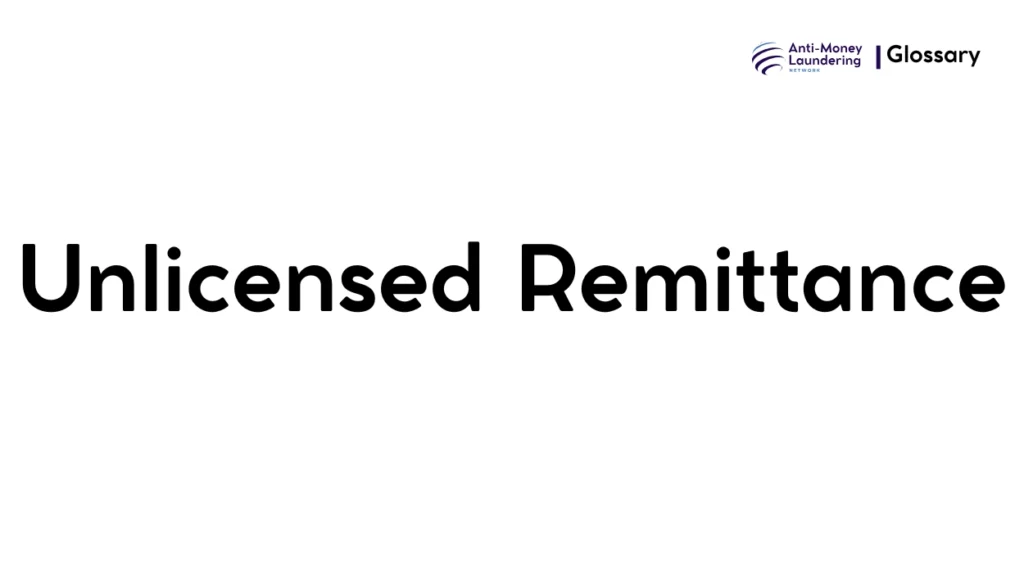Definition
Unlicensed Remittance in AML refers to the operation of money or value transfer services without the necessary regulatory license or authorization from relevant financial authorities. These entities or networks facilitate the transfer of funds across or within borders, often bypassing official financial systems, and operate outside the oversight required by laws designed to prevent money laundering and terrorist financing. Unlicensed remittance is commonly associated with underground banking systems like hawala, smurfing, or informal value transfer systems which lack transparency and pose significant AML risks.
Purpose and Regulatory Basis
Unlicensed remittance is critically relevant in AML frameworks because such unregulated channels can be exploited by criminals to move illicit funds covertly. These informal methods undermine global efforts to track and curb financial crimes. Regulatory bodies including the Financial Action Task Force (FATF), the USA PATRIOT Act in the United States, and the European Union’s Anti-Money Laundering Directives (AMLD) emphasize licensing and strict oversight of remittance service providers to ensure compliance with AML/CFT (Combating the Financing of Terrorism) standards. The licensing criteria generally include customer due diligence (CDD), transaction monitoring, suspicious activity reporting, and sanction screening. Licensed providers help maintain the integrity of the financial system, making unlicensed operations a major regulatory concern.
When and How it Applies
Unlicensed remittance applies when entities engage in transferring money without registration, licensing, or regulatory approval. This includes informal networks used in ethnic or diaspora communities, traditional hawala systems, and newly digital or mobile-based platforms that evade formal controls. Triggers for regulatory intervention include suspicious transaction patterns, unusually high volumes of cash transfers, missing CDD information, or cross-border transactions through unknown agents. Examples include money transfer businesses operating without regulatory registration or agents conducting remittances without proper oversight, thus increasing risks of money laundering, terrorist financing, and illicit fund movement.
Types or Variants
Types of unlicensed remittance generally fall into:
- Traditional informal systems (Hawala, Hundi): Based on trust and community ties, without formal documentation.
- Underground banking: Networks that knowingly transfer money without regulation.
- Unregistered Money Transfer Operators (MTOs): Businesses offering remittance services without meeting licensing requirements.
- Unauthorized agents or digital platforms: E.g., mobile money or virtual asset service providers operating without compliance structures.
Each variant presents unique AML challenges given their operational opacity and lack of formal records.
Procedures and Implementation
Financial institutions and remittance service providers must implement robust AML programs to prevent unlicensed remittance activities. This includes:
- Conducting thorough customer due diligence (CDD) and enhanced due diligence (EDD) for high-risk customers.
- Ensuring all agents and partners are properly licensed and vetted.
- Implementing transaction monitoring systems capable of detecting suspicious patterns typical of unlicensed remittance.
- Regular sanction screening and watchlist checks against FATF and other official sanction lists.
- Reporting suspicious transactions promptly to Financial Intelligence Units (FIUs).
- Training staff to recognize red flags related to unlicensed money transfers.
- Conducting independent audits and compliance reviews to ensure program effectiveness.
Impact on Customers/Clients
From a customer’s perspective, unlicensed remittance services carry risks including lack of consumer protection, potential loss of funds, and legal liabilities. Customers using licensed providers benefit from safer, transparent services with mechanisms for dispute resolution. Restrictions and increased scrutiny are placed on customers suspected of using unlicensed channels to ensure AML compliance. Therefore, clients must be made aware of the importance of using only licensed entities to protect their financial transactions and personal data.
Duration, Review, and Resolution
AML compliance concerning unlicensed remittance is continuous, involving ongoing monitoring and periodic review of transactions and business relationships. Financial institutions must review and update their AML programs regularly to address emerging risks associated with unlicensed remittance activities. Resolution processes may involve blocking suspicious transactions, terminating business relationships with unlicensed entities, and cooperating with regulatory and law enforcement authorities for investigation and sanctioning.
Reporting and Compliance Duties
Institutions have a duty to report any suspicious transactions linked to unlicensed remittance to the relevant FIUs. Failure to report or compliance breaches can lead to severe penalties including fines, sanctions, or criminal prosecution. Documentation and record-keeping requirements must be strictly followed to provide audit trails. Regulatory exams and independent reviews determine adherence to AML laws, assessing the effectiveness of controls related to remittance licensing and transaction monitoring.
Related AML Terms
Unlicensed remittance is closely related to several AML concepts such as:
- Informal Value Transfer Systems (IVTS)
- Hawala and Hundi
- Suspicious Activity Reporting (SAR)
- Customer Due Diligence (CDD) and Enhanced Due Diligence (EDD)
- Sanction Screening
- Financial Intelligence Units (FIUs)
Understanding these terms helps institutions create comprehensive strategies to combat risks posed by unlicensed remittance.
Challenges and Best Practices
Challenges include the difficulty of detecting informal and trust-based unlicensed systems, cross-border jurisdictional complexities, and balancing regulatory enforcement with financial inclusion. Best practices involve leveraging technology such as AI for transaction monitoring, establishing clear agent onboarding and oversight procedures, conducting ongoing employee training, and cooperating internationally to curb unlicensed remittance networks. Institutions should adopt a risk-based approach tailored to the specific remittance environment they operate in.
Recent Developments
Recent developments focus on digital transformation of remittance services and regulatory tightening. Digital and mobile money platforms require new AML frameworks to address vulnerabilities in virtual asset service providers (VASPs). Regulatory bodies are adapting AMLD guidelines and FATF recommendations to include digital remittance and unlicensed operators. Advanced compliance technologies, including real-time monitoring and blockchain analytics, are increasingly deployed to detect and prevent abuses of unlicensed remittance services.
Unlicensed remittance involves unauthorized money transfer services posing significant risks to AML compliance frameworks worldwide. It undermines efforts to detect and prevent money laundering and terrorist financing by operating outside regulatory oversight. Financial institutions must implement stringent policies, controls, and technological solutions to manage these risks effectively. Awareness and vigilance around unlicensed remittance protect the financial system’s integrity and ensure compliance with international AML standards.

